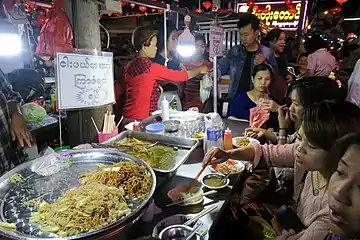Street food
Street food consists of ready-to-eat foods or drinks sold by a hawker, or vendor, in a street or other public place, such as at a market or fair. It is often sold from a portable food booth,[1] food cart, or food truck and meant for immediate consumption. Some street foods are regional, but many have spread beyond their region of origin. Most street foods are classified as both finger food and fast food, and are typically cheaper than restaurant meals. The types of street food varies among regions and cultures in different countries around the world.[2] According to a 2007 study from the Food and Agriculture Organization, 2.5 billion people eat street food every day.[3] A majority of middle-income consumers[4] rely on the quick access and cheap service of street food for daily nutrition and job opportunities, especially in developing countries.

Today, people may purchase street food for a number of reasons, such as convenience, to get flavourful food for a reasonable price in a sociable setting, prompt service, to try ethnic cuisines, or for nostalgia.[5]
Rising concerns of street food includes health hazards and sanitation issues, illegal usage of public or private areas, social and ethical problems, and traffic congestion.[4]
History
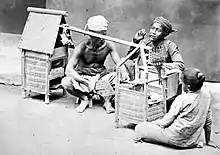

In ancient Greece, small fried fish were a street food,[6] however, the Greek philosopher Theophrastus held the custom of street food in low regard.[7] Evidence of a large number of street food vendors was discovered during the excavation of Pompeii.[8] Street food was widely consumed by poor urban residents of ancient Rome whose tenement homes did not have ovens or hearths.[9] Chickpea soup[10] with bread and grain paste[11] were common meals. In ancient China, street food generally catered to the poor, though wealthy residents would send servants to buy street food and bring it back for them to eat in their homes.[9]
A traveling Florentine reported in the late 14th century that in Cairo, people brought picnic cloths made of rawhide to spread on the streets and sit on while they ate their meals of lamb kebabs, rice, and fritters that purchased from street vendors.[12] In Renaissance Turkey, many crossroads had vendors selling "fragrant bites of hot meat", including chicken and lamb that had been spit-roasted.[13] In 1502, Ottoman Turkey became the first country to legislate and standardize street food.[14]
Aztec marketplaces had vendors who sold beverages such as atolli ("a gruel made from maize dough"), almost 50 types of tamales (with ingredients that ranged from the meat of turkey, rabbit, gopher, frog and fish to fruits, eggs and maize flowers),[15] as well as insects and stews.[16] Spanish colonization brought European food stocks like wheat, sugarcane and livestock to Peru, but most commoners continued to primarily eat their traditional diets. Imports were only accepted at the margins of their diet, for example, grilled beef hearts sold by street vendors.[17] Some of Lima's 19th-century street vendors such as "Erasmo, the 'negro' sango vendor" and Na Aguedita are still remembered today.[18]
During the American Colonial period, "street vendors sold oysters, roasted corn ears, fruit, and sweets at low prices to all classes." Oysters, in particular, were a cheap and popular street food until around 1910 when overfishing and pollution caused prices to rise.[19] Street vendors in New York City faced a lot of opposition. After previous restrictions had limited their operating hours, street food vendors were completely banned in New York City by 1707.[20] Many women of African descent made their living selling street foods in America in the 18th and 19th centuries, with products ranging from fruit, cakes, and nuts in Savannah, to coffee, biscuits, pralines, and other sweets in New Orleans.[21] Cracker Jack started as one of many street food exhibits at the Columbian Exposition.[22]
In the 19th century, street food vendors in Transylvania sold gingerbread-nuts, cream mixed with corn, as well as bacon and other meat fried on top of ceramic vessels with hot coals inside.[23] French fries, consisting of fried strips of potato, probably originated as a street food in Paris in the 1840s.[24] Street foods in Victorian London included tripe, pea soup, pea pods in butter, whelk, prawns, and jellied eels.[25] Mumbai, India has more than a half a million of street food vendors.

Street food culture in China was first developed in the Tang Dynasty and continued to evolve over millennia. Street food continues to play a major role in Chinese cuisine with regional street food generating a strong interest in culinary tourism.[26] Because of the Chinese diaspora, Chinese street food has had a major influence on other cuisines across Asia and even introduced the concept of a street food culture to other countries. The street food culture of Southeast Asia was established by coolie workers imported from China during the late 19th century.[27]
Ramen, originally brought to Japan by Chinese immigrants about 100 years ago, began as a street food for laborers and students. However, it soon became a "national dish" and even acquired regional variations.[28]
In Thailand, street food was commonly sold by the ethnic Chinese population of Thailand. It did not become popular among native Thai people until the early-1960s when, due to urban population growth and rising incomes,[29] it had "displaced home-cooking."[9] About 76% of urban residents in Thailand regularly visit street food vendors. The rise of the country's tourism industry has also contributed to the popularity of Thai street food. Thailand's 103,000 street food vendors alone generated 270 billion baht in revenues in 2017. Suvit Maesincee, Minister of Higher Education, Science, Research and Innovation, expects the Thai street food segment to grow by six to seven percent annually from 2020 forward.[30] Multiple studies showed that contamination of food that street food vendors sell is at the same level as the contamination at restaurants. [31] An estimated 2% or 160,000 vendors provide street food for Bangkok's 8 million people.[32]
In Indonesia — especially Java, travelling food and drink vendors have a long history, as they were described in temples bas reliefs dated from 9th century, as well as mentioned in 14th century inscription as a line of work. In Indonesia, street food is sold from carts and bicycles.During colonial Dutch East Indies period circa 19th century, several street food were developed and documented, including satay and dawet (cendol) street vendors. The current proliferation of Indonesia's vigorous street food culture is contributed by the massive urbanization in recent decades that has opened opportunities in food service sectors. This took place in the country's rapidly expanding urban agglomerations, especially in Greater Jakarta, Bandung and Surabaya.[33] Some cultures consider rude walking on the street while eating.[34]
Around the world
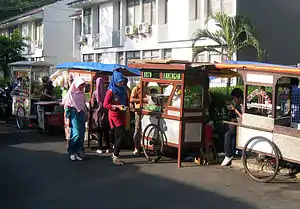

Street food vending is found all around the world, but varies greatly between regions and cultures.[35]
Dorling Kindersley describes the street food of Vietnam as being "fresh and lighter than many of the cuisines in the area" and "draw[ing] heavily on herbs, chile peppers and lime", while street food of Thailand is "fiery" and "pungent with shrimp paste ... and fish sauce." [36] Street food in Thailand offers a varied selection of ready-to-eat meals, snacks, fruits and drinks. The capital of Thailand, Bangkok, has been listed as one of the best places for street food.[37][38] Popular street offerings include pad thai (stir fried rice noodle), green papaya salad, sour tom yum soup, Thai curries and mango sticky rice.
Indonesian street food is a diverse mix of local Indonesian, Chinese, and Dutch influences.[39] Indonesian street food is often strongly flavored and spicy. Much of the street food in Indonesia is fried, such as fritters, nasi goreng and ayam goreng. Bakso (meatball soup), satay (skewered chicken) and gado-gado (vegetable salad served in peanut sauce) are also popular.[40]
There is a stigma in Japan against eating on the move. However, during special occasions such as festivals, the streets of Tokyo are filled with vendors that serve food such as odango, sashimi, oyster, and octopus.
Indian street food is as diverse as Indian cuisine. Every place has its own specialties to offer. Some of the more popular street food dishes are vada pav, misal pav, chole bhature, parathas, bhel puri, sev puri, gol gappa, aloo tikki, kebabs, tandoori chicken, samosas, kachori, idli, pohe, egg bhurji, pav bhaji, pulaw, pakora, lassi, kulfi and falooda. In Hindi speaking regions of India, street food is popularly known as nukkadwala food ("corner" food). In South India, foods like mirchi bajji, punugulu, and mokkajonna (corn roasted on coal) are common street foods, along with breakfast items like idli, dosa and bonda. While some vendors streamline the recipes of popular dishes to sell them on the street, several restaurants have taken their inspiration from the street food of India.[41]
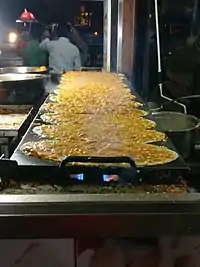
In the Middle East falafel is very popular. Vendors sell it on street corners in Israel, Egypt, and Syria. Another food sold commonly on the street in Egypt is ful, a slow-cooked fava bean dish.[42]
In Denmark, sausage wagons allow passersby to purchase sausages and hot dogs.
In the Caribbean Islands a traditional dish is Jamaican jerk chicken. The original marinade calls for Caribbean ingredients such as scotch bonnet peppers, allspice berries and sometimes wood from laurel trees.[43]

Mexican street food is known as antojitos (translated as "little cravings") and features several varieties of tacos, such as tacos al pastor, as well as huaraches and other maize based foods.
New York City's signature street food is the hot dog, but New York street food also includes everything from spicy Middle Eastern falafel or Jamaican jerk chicken to Belgian waffles [44]
In Hawaii, the local street food tradition of "plate lunch" (rice, macaroni salad, and a portion of meat) was inspired by the bento of the Japanese who had been brought to Hawaii as plantation workers.[45]
Cultural and economic aspects
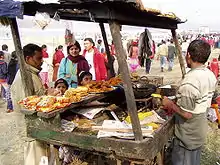
Because of differences in culture, social stratification and history, the ways in which family street vendor enterprises are traditionally created and run vary in different areas of the world.[46] Often, women's success in the street food market depends on trends of gender equality. This is evidenced in Bangladesh, where few women are street vendors. However, in Nigeria and Thailand, women dominate the street food trade.[47] Doreen Fernandez says that Filipino cultural attitudes towards meals is one "cultural factor operating in the street food phenomenon" in the Philippines because eating "food out in the open, in the market or street or field" is "not at odds with the meal indoors or at home" where "there is no special room for dining".[23]
Other cultural phenomena that affect the street food market include the cultural implications of eating while walking down the street. In some cultures, this is considered to be rude,[48] such as Japanese[49] or Swahili cultures. Despite not being allowed for adults, it is culturally acceptable for children to do.[50] In India, Henrike Donner wrote about a "marked distinction between food that could be eaten outside, especially by women," and the food prepared and eaten at home, with some non-Indian food being too "strange" or tied too closely to non-vegetarian preparation methods to be made at home.[51]
In Tanzania's Dar es Salaam region, street food vendors produce economic benefits beyond their families. Because street food vendors purchase local fresh foods, urban gardens and small-scale farms in the area have expanded.[52] In the United States, street food vendors are credited with supporting New York City's rapid growth by supplying meals for the city's merchants and workers.[53] Proprietors of street food in the United States have had a goal of upward mobility, moving from selling on the street to their own shops.[5] However, in Mexico, an increase in street vendors has been seen as a sign of deteriorating economic conditions in which food vending is the only employment opportunity that unskilled labor who have migrated from rural areas to urban areas are able to find.[16]
In 2002, Coca-Cola reported that China, India, and Nigeria were some of its fastest-growing markets: markets where the company's expansion efforts included training and equipping mobile street vendors to sell its products.[52]
The libertarian Reason magazine states that in US cities, food trucks are subject to regulations designed to prevent them from competing with brick and mortar restaurants. For example, in Chicago, a regulation prevents food trucks "...from selling food within 200 feet of brick-and-mortar restaurants and, hence, prohibit them from operating throughout the city's downtown area," which critics have called an "anti-competitive" rule for food truck operators.[54]
Since 1984, Folsom Street Fair in San Francisco is home of one of the most diverse street food fairs.[55] In addition to much leather, and people in various states of dress and undress, the event features an outdoor food court serving a variety of street food. For donations of $10 or more, visitors get a $2 discount on each drink purchased at the fair. In 2018, the street photographer Michael Rababy documented it in his book, Folsom Street Food Court.[55][56]
Netflix has also featured the street foods of the world through its popular TV series Street Food, with the first volume focusing on Asia, and second on Latin America.[57][58][59]
Health and safety
As early as the 14th century, government officials oversaw street food vendor activities.[12] With the increasing pace of globalization and tourism, the safety of street food has become one of the major concerns of public health, and a focus for governments and scientists to raise public awareness.[60][61][62][63] However, despite concerns about contamination at street food vendors, the incidence of such is low, with studies showing rates comparable to restaurants.[64]
In 2002, a sampling of 511 street foods in Ghana by the World Health Organization showed that most had microbial counts within the accepted limits,[65] and a different sampling of 15 street foods in Calcutta showed that they were "nutritionally well balanced", providing roughly 200 kcal (Cal) of energy per rupee of cost.[66]
In the United Kingdom, the Food Standards Agency has provided comprehensive guidance of food safety for the vendors, traders and retailers of the street food sector since 2000.[67] Other effective ways of enhancing the safety of street foods include: mystery shopping programs, training, rewarding programs to vendors, regulatory governing and membership management programs, and technical testing programs.[68][69][70][71][72]
Despite knowledge of the risk factors, actual harm to consumers’ health is yet to be fully proven and understood. Due to difficulties in tracking cases and the lack of disease-reporting systems, follow-up studies proving actual connections between street food consumption and food-borne diseases are still very few. Little attention has been devoted to consumers and their eating habits, behaviors and awareness. The fact that social and geographical origins largely determine consumers’ physiological adaptation and reaction to foods—whether contaminated or not—is neglected in the literature.[73]
In the late 1990s, the United Nations and other organizations began to recognize that street vendors had been an underused method of delivering fortified foods to populations, and in 2007, the UN Food and Agriculture Organization recommended considering methods of adding nutrients and supplements to street foods that are commonly consumed by the particular culture.[64]
See also
References
- Artemis P. Simopoulos, Ramesh Venkataramana Bhat (2000). Street Foods. Karger Publishers, 2000. p. vii. ISBN 9783805569279. Retrieved 18 April 2011.
- Wanjek, Christopher; Office, International Labour (2005). Food at Work: Workplace Solutions for Malnutrition, Obesity and Chronic Diseases. International Labour Organization. ISBN 978-92-2-117015-0.
- "Spotlight: School Children, Street Food and Micronutrient Deficiencies in Tanzania". Rome, Italy: Food and Agriculture Organization of the United Nations. February 2007. Archived from the original on 9 April 2015. Retrieved 20 February 2008.
- "Food for the Cities: Street foods". www.fao.org. Retrieved 15 March 2020.
- Smith, Andrew F. (May 2007). The Oxford Companion to American Food and Drink. ISBN 9780195307962. Retrieved 17 August 2012.
- Cathy K. Kaufman (30 August 2006). Cooking in Ancient Civilizations. ISBN 9780313332043. Retrieved 17 August 2012.
- Artemis P. Simopoulos (2000). Street Foods. ISBN 9783805569279. Retrieved 16 August 2012.
- Freedman, Paul; Freedman, Professor Paul (2007). Food: The History of Taste. ISBN 9780520254763. Retrieved 16 August 2012.
- B. W. Higman (8 August 2011). How Food Made History. ISBN 9781444344653. Retrieved 16 August 2012.
- Dalby, Andrew (18 June 2003). Food in the Ancient World A-Z. ISBN 9780415232593. Retrieved 16 August 2012.
- Civitello, Linda (29 March 2011). Cuisine and Culture: A History of Food and People. ISBN 9781118098752. Retrieved 17 August 2012.
- Mary Snodgrass (27 September 2004). Encyclopedia of Kitchen History. ISBN 9780203319178. Retrieved 16 August 2012.
- Snodgrass, Mary (27 September 2004). Encyclopedia of Kitchen History. ISBN 9780203319178. Retrieved 16 August 2012.
- Kraig, Bruce; Colleen Taylor Sen Ph, D. (9 September 2013). Street Food Around the World. ISBN 9781598849554.
- Evans, Susan (2001). Archaeology of Ancient Mexico and Central America: An Encyclopedia. ISBN 9780815308874. Retrieved 17 August 2012.
- Long Towell Long, Luis Alberto Vargas (2005). Food Culture In Mexico. ISBN 9780313324314. Retrieved 17 August 2012.
- J. Pilcher (20 December 2005). Food In World History. ISBN 9780203970058. Retrieved 16 August 2012.
- Albala, Ken (25 May 2011). Food Cultures of the World Encyclopedia. Boo. ISBN 9780313376269. Retrieved 17 August 2012.
- Katherine Leonard Turner (2008). Good Food for Little Money: Food and Cooking Among Urban Working-class ... ISBN 9780549754237. Retrieved 17 August 2012.
- Artemis P. Simopoulos (2000). Street Foods. ISBN 9783805569279. Retrieved 16 August 2012.
- Bower, Anne L. (December 2008). African American Foodways: Explorations of History and Culture –. ISBN 9780252076305. Retrieved 17 August 2012.
- Andrew F. Smith (2011). Eating History: 30 Turning Points in the Making of American Cuisine. ISBN 9780231140935. Retrieved 16 August 2012.
- Walker, Harlan (1992). Oxford Symposium on Food and Cookery 1991: Public Eating : Proceedings. ISBN 9780907325475. Retrieved 17 August 2012.
- Marshall, Bill (2005). France and the Americas: Culture, Politics, and History. ISBN 9781851094110. Retrieved 16 August 2012.
- Clarissa Dickson Wright (13 October 2011). A History of English Food. ISBN 9781448107452. Retrieved 16 August 2012.
- Wang Dingbao. "自負". 唐摭言 (Tang Zhiyan).
- Carlo Petrini (October 2001). Slow Food: Collected Thoughts on Taste, Tradition, and the Honest Pleasures ... ISBN 9781603581721. Retrieved 19 March 2019.
- Assmann, Stephanie; Rath, Eric C. (2010). Japanese Foodways, Past and Present. ISBN 9780252077524. Retrieved 17 August 2012.
- Thompson, David (2009). Thai Street Food. ISBN 9781580082846. Retrieved 16 August 2012.
- Hutasingh, Onnucha (17 February 2020). "Smart food cart to aid gastronomic tourism". Bangkok Post. Retrieved 17 February 2020.
- "History of Street Food and Interesting Facts". History of Fast Food. 2021. Retrieved 3 January 2021.
- Poon, Linda (14 April 2017). "Bangkok's Street Vendors Are Not the Enemies of Public Space". Bloomburg City Lab. Retrieved 3 January 2021.
- Firman, Tommy (12 May 2012). "Urbanization and urban development patterns". The Jakarta Post.
- "Street Food History - Facts about Street Food Vending". www.historyoffastfood.com. Retrieved 15 March 2020.
- Wanjek, Christopher (2005). Food At Work: Workplace Solutions For Malnutrition, Obesity And Chronic Diseases. ISBN 9789221170150. Retrieved 16 August 2012.
- Kindersley, Dorling (3 October 2011). Ultimate Food Journeys: The World's Best Dishes and Where to Eat Them. ISBN 9780756695880. Retrieved 17 August 2012.
- Wiens, Mark (9 May 2011). "Top 16 Bangkok Street Food Sanctuaries (Are You Ready to Eat?)". Migrationology.
- "The 10 best street food cities in the world, per VirtualTourist.com, Frommer's". NY Daily News.
- Jing Xuan Teng (28 April 2016). "The Best Street Food in Jakarta, Indonesia". The Culture Trip.
- "Indonesian Street food". Food & Travel.com.au.
- "Nukkadwala -Inspired by a billion foodies". Nukkadwala. Retrieved 21 March 2018.
- Anderson, Heather Arndt (2013). Breakfast: A History. Lanham, MD: AltaMira Press. p. 33. ISBN 978-0-7591-2165-2.
- "Jamaican "Jerk" Chicken Recipe". Pepper. 29 November 2018. Retrieved 21 October 2019.
- Kindersley, Dorling (3 October 2011). Ultimate Food Journeys: The World's Best Dishes and Where to Eat Them. ISBN 9780756695880. Retrieved 17 August 2012.
- Nina L. Etkin (15 September 2009). Foods of Association: Biocultural Perspectives on Foods and Beverages that ... ISBN 9780816527779. Retrieved 17 August 2012.
- Esther Ngan-Ling Chow (January 1994). Women, the Family, and Policy: A Global Perspective. ISBN 9780791417850. Retrieved 16 August 2012.
- Tinker, Irene (1997). Street Foods: Urban Food and Employment in Developing Countries. Oxford University Press. ISBN 9780195104356. Retrieved 17 August 2012.
- Dan Knox, Kevin Hannam (25 March 2010). Understanding Tourism: A Critical Introduction. ISBN 9781412922784. Retrieved 17 August 2012.
- Michael Ashkenazi, Jeanne Jacob (2003). Food Culture in Japan. ISBN 9780313324383. Retrieved 17 August 2012.
- Albala, Ken (25 May 2011). Food Cultures of the World Encyclopedia [4 volumes]: [Four Volumes]. ABC-CLIO. pp. 2–. ISBN 9780313376276. Retrieved 4 April 2014.
- Donner, Henrike (2011). Being Middle-Class in India: A Way of Life. ISBN 9780415671675. Retrieved 16 August 2012.
- Globalization of Food Systems in Developing Countries: Impact on Food ... Issue #83. FAO. 2004. ISBN 9789251052280. Retrieved 17 August 2012.
- Start Your Own Food Truck Business – Entrepreneur Press. Entrepreneur Press. June 2011. ISBN 9781613081143. Retrieved 17 August 2012.
- Linnekin, Baylen (3 March 2018). "Food Trucks Still Under Attack from Regulators". reason.com. Reason. Retrieved 3 August 2019.
- Rababy, Michael (2018). Folsom Street Food Court. 1133 Venice Boulevard Los Angeles California 90015: Delancey Street Press. p. 64. ISBN 978-0692183731.CS1 maint: location (link)
- Bull, Chris (26 September 2018). "PHOTOS: Folsom Street Fair may be all about the hot guys, but don't forget the street food". GayCities Blog. Retrieved 10 April 2020.
- Wilkinson, Alissa. "Netflix's wonderful Street Food focuses on the human aspect of ordinary food". Vox. Vox Media, LLC. Retrieved 9 September 2020.
- Cortez, Mario A. "'Street Food: Latin America' Is a Mouth-Watering, Welcome Escape". Remezcla. Remezcla. Retrieved 9 September 2020.
- Anderson, John. "'Street Food: Latin America' Review: A Platter of Vicarious Delights". The Wall Street Journal. Dow Jones & Company, Inc. Retrieved 9 September 2020.
- Mukhola, Murembiwa Stanley. "Guidelines for an Environmental Education Training Programme for Street Food Vendors in Polokwane City" (PDF). Retrieved 23 November 2007.
- Mukhola, Murembiwa Stanley. The thesis contents. OCLC 82364718. Retrieved 23 November 2007.
- Lues, Jan F. R.; Rasephei, MR; Venter, P; Theron, MM; et al. (2006). "Assessing food safety and associated food handling practices in street food vending". International Journal of Environmental Health Research. 16 (5): 319–328. doi:10.1080/09603120600869141. PMID 16990173. S2CID 27054452.
- Food and Agriculture Organization of the United Nations. "The informal food sector" (PDF). Retrieved 20 June 2019.
- Nina L. Etkin (15 September 2009). Foods of Association: Biocultural Perspectives on Foods and Beverages that. ISBN 9780816527779. Retrieved 16 August 2012.
- Globalization of Food Systems in Developing Countries: Impact on Food ... 2004. ISBN 9789251052280. Retrieved 17 August 2012.
- Artemis P. Simopoulos (2000). Street Foods. ISBN 9783805569279. Retrieved 17 August 2012.
- Food Standards Agency. "Safer food, better business". Retrieved 24 November 2007.
- Sydney Market Limited. "Retailers Support Program". Archived from the original on 29 August 2007. Retrieved 25 November 2007.
- Queen Victoria Market. "Food Safety Supervisor Course". Archived from the original on 12 October 2007. Retrieved 25 November 2007.
- Green City Market. "Producer Rules and Regulations". Retrieved 25 November 2007.
- Adelaide Showgrounds Farmers Market. "How To Become A Stallholder". Archived from the original on 30 November 2012. Retrieved 27 November 2007.
- Brisbane Markets Limited. "Chemical residue and microbial testing program for Australia's fresh produce industry" (PDF). Archived from the original (PDF) on 29 August 2007. Retrieved 27 November 2007.
- MARRAS S.R. (2014). "Comparative Analysis of Legislative Approaches to Street Food in South American Metropolises." In Cardoso R., Companion M., Marras S. (eds.). Street Food. Culture, Economy, Health and Governance. London & NY: Routledge. Pp.15–45.
External links
 Media related to street food at Wikimedia Commons
Media related to street food at Wikimedia Commons Street food travel guide from Wikivoyage
Street food travel guide from Wikivoyage
